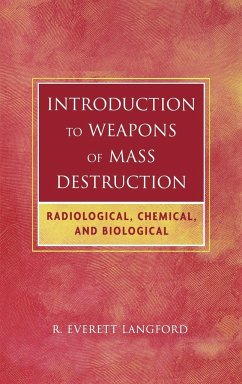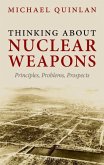R. Everett Langford
Introduction to Weapons of Mass Destruction
Radiological, Chemical, and Biological
R. Everett Langford
Introduction to Weapons of Mass Destruction
Radiological, Chemical, and Biological
- Gebundenes Buch
- Merkliste
- Auf die Merkliste
- Bewerten Bewerten
- Teilen
- Produkt teilen
- Produkterinnerung
- Produkterinnerung
Crucial information on nuclear, chemical, and biological weapons From the diseased animal carcass hurled over the wall of a besieged castle to the nuclear suitcase bomb carried by a clandestine operative, the threat of unconventional weapons has always been a feature of warfare. Today's danger comes mainly from the potential use of nuclear, biological, and chemical (NBC) weapons of mass destruction (WMD) by international terrorists or rogue states. False alarms and misinformation about these weapons have abounded in the jittery post-9/11 atmosphere. To understand and deal with the actual…mehr
Andere Kunden interessierten sich auch für
![Thinking about Nuclear Weapons Thinking about Nuclear Weapons]() Michael QuinlanThinking about Nuclear Weapons100,99 €
Michael QuinlanThinking about Nuclear Weapons100,99 €![Technology and the Proliferation of Nuclear Weapons Technology and the Proliferation of Nuclear Weapons]() Richard KokoskiTechnology and the Proliferation of Nuclear Weapons393,99 €
Richard KokoskiTechnology and the Proliferation of Nuclear Weapons393,99 €![Unconventional Weapons and International Terrorism Unconventional Weapons and International Terrorism]() Unconventional Weapons and International Terrorism142,99 €
Unconventional Weapons and International Terrorism142,99 €![A Memorial To The Congress Of The United States, On Behalf Of The Sufferers From The Bombardment And Destruction Of Greytown A Memorial To The Congress Of The United States, On Behalf Of The Sufferers From The Bombardment And Destruction Of Greytown]() A Memorial To The Congress Of The United States, On Behalf Of The Sufferers From The Bombardment And Destruction Of Greytown29,99 €
A Memorial To The Congress Of The United States, On Behalf Of The Sufferers From The Bombardment And Destruction Of Greytown29,99 €![Gebäuderäumungen Gebäuderäumungen]() Wolfgang J. FriedlGebäuderäumungen29,90 €
Wolfgang J. FriedlGebäuderäumungen29,90 €![CBRN-Schutz in der Gefahrenabwehr CBRN-Schutz in der Gefahrenabwehr]() Andreas KüharCBRN-Schutz in der Gefahrenabwehr39,00 €
Andreas KüharCBRN-Schutz in der Gefahrenabwehr39,00 €![Arbeitsschutzmanagement in der Feuerwehr Arbeitsschutzmanagement in der Feuerwehr]() Oliver TittmannArbeitsschutzmanagement in der Feuerwehr45,00 €
Oliver TittmannArbeitsschutzmanagement in der Feuerwehr45,00 €-
-
-
Crucial information on nuclear, chemical, and biological weapons
From the diseased animal carcass hurled over the wall of a besieged castle to the nuclear suitcase bomb carried by a clandestine operative, the threat of unconventional weapons has always been a feature of warfare. Today's danger comes mainly from the potential use of nuclear, biological, and chemical (NBC) weapons of mass destruction (WMD) by international terrorists or rogue states. False alarms and misinformation about these weapons have abounded in the jittery post-9/11 atmosphere. To understand and deal with the actual threat posed requires basing response plans, policy, and reporting on actual facts.
Introduction to Weapons of Mass Destruction separates fact from fiction about NBC weaponry by providing clear, technically precise information. For each family of weapon, coverage in this handbook includes:
_ History and background information
_ Agent types and delivery mechanisms
_ Effects of exposure
_ Protection
_ Safe storage and handling
_ Decontamination
_ Medical treatments
Drawing from a broad array of military, scientific, and safety resources, this text offers both accessibility to the general public and accuracy and depth for professional emergency responders. Additional resources include a bibliography of references and a list of addresses and telephone numbers of federal and military agencies and professional organizations of interest. With full coverage of WMDs, from high-tech, genetically modified organisms to rudimentary radiological "dirty bombs," Introduction to Weapons of Mass Destruction is an essential reference for understanding and responding to these dangerous warfare agents.
Hinweis: Dieser Artikel kann nur an eine deutsche Lieferadresse ausgeliefert werden.
From the diseased animal carcass hurled over the wall of a besieged castle to the nuclear suitcase bomb carried by a clandestine operative, the threat of unconventional weapons has always been a feature of warfare. Today's danger comes mainly from the potential use of nuclear, biological, and chemical (NBC) weapons of mass destruction (WMD) by international terrorists or rogue states. False alarms and misinformation about these weapons have abounded in the jittery post-9/11 atmosphere. To understand and deal with the actual threat posed requires basing response plans, policy, and reporting on actual facts.
Introduction to Weapons of Mass Destruction separates fact from fiction about NBC weaponry by providing clear, technically precise information. For each family of weapon, coverage in this handbook includes:
_ History and background information
_ Agent types and delivery mechanisms
_ Effects of exposure
_ Protection
_ Safe storage and handling
_ Decontamination
_ Medical treatments
Drawing from a broad array of military, scientific, and safety resources, this text offers both accessibility to the general public and accuracy and depth for professional emergency responders. Additional resources include a bibliography of references and a list of addresses and telephone numbers of federal and military agencies and professional organizations of interest. With full coverage of WMDs, from high-tech, genetically modified organisms to rudimentary radiological "dirty bombs," Introduction to Weapons of Mass Destruction is an essential reference for understanding and responding to these dangerous warfare agents.
Hinweis: Dieser Artikel kann nur an eine deutsche Lieferadresse ausgeliefert werden.
Produktdetails
- Produktdetails
- Verlag: Wiley & Sons
- 1. Auflage
- Seitenzahl: 424
- Erscheinungstermin: 19. Februar 2004
- Englisch
- Abmessung: 240mm x 161mm x 27mm
- Gewicht: 709g
- ISBN-13: 9780471465607
- ISBN-10: 0471465607
- Artikelnr.: 14215674
- Herstellerkennzeichnung
- Libri GmbH
- Europaallee 1
- 36244 Bad Hersfeld
- gpsr@libri.de
- Verlag: Wiley & Sons
- 1. Auflage
- Seitenzahl: 424
- Erscheinungstermin: 19. Februar 2004
- Englisch
- Abmessung: 240mm x 161mm x 27mm
- Gewicht: 709g
- ISBN-13: 9780471465607
- ISBN-10: 0471465607
- Artikelnr.: 14215674
- Herstellerkennzeichnung
- Libri GmbH
- Europaallee 1
- 36244 Bad Hersfeld
- gpsr@libri.de
R. EVERETT LANGFORD is a retired U.S. Army Lieutenant Colonel who commanded the Army's Toxicology Research Laboratory from 1991 to 1998. Dr. Langford has thirty years of experience in radiological health and industrial hygiene, working for the government in research, educational institutions as a college professor, the military as a subject-matter expert, and in industry as a manager and safety expert. Also, he is certified as an Industrial Hygienist, a Safety Professional, and a Professional Environmental Auditor.
1. Weapons of Mass Destruction (WMD).
Introduction to WMD.
Nuclear Weapons.
Biological Weapons.
Chemical Weapons.
Similarities of Nuclear, Biological, and Chemical Weapons.
Differences Among Nuclear, Biological, and Chemical Weapons.
Aerosols.
Dispersion.
Exposure versus Dose.
Toxicity, Dose, and Effects.
Effects of Nuclear, Biological, and Chemical Weapons on People.
Human Anatomy and Physiology.
The Skin.
Ocular System.
Digestive System.
Nervous System.
Reproductive System.
Endocrine System.
Blood and Circulatory System.
Lymphatic System.
Urinary System.
The Liver.
Summary.
PART 1: RADIOLOGICAL WEAPONS.
2. Nuclear Radiation.
Atoms and Elements.
Introduction to Nuclear Radiation.
Process of Alpha Radiation.
Process of Beta Radiation.
Process of Gamma Radiation.
Process of Neutron Radiation.
Linear Energy Transfer (LET), Stopping Power , and Effects.
Fission Fragments.
Physiological Effects of Alpha Radiation.
Physiological Effects of Beta Radiation.
Physiological Effects of Gamma Radiation.
Physiological Effects of Neutron Radiation.
Time-Distance Shielding.
Radiation Shielding.
Summary.
3. Brief History of Nuclear Weapons.
Introduction.
Pre-World War Two.
World War Two Efforts.
British and Commonwealth World War Two Developments.
British and Commonwealth Post-War Developments.
Russian Nuclear Weapons.
French, Chinese, Indian, Pakistan, Israeli, and South African Nuclear
Weapons.
People's Republic of China.
India.
Pakistan.
Israel.
South Africa.
Post-War U.S. Developments.
Modern Weapons.
Arms Limitations.
Test Ban Treatise.
Nuclear Nonproliferation Treaty.
Weapons Accidents and Missing Weapons.
Today.
Terrorism.
World War II Dirty Bomb Operation.
4. Types of Nuclear Weapons.
Early Nuclear Weapons Designs.
Second Generation Nuclear Weapons.
The Hydrogen Bomb.
Modern Nuclear Weapons.
Delivery Systems.
Weapons Detonator.
Fission Initiator.
Nuclear Power Reactor.
Nuclear Reactor Waste.
"Dirty" Bomb.
Dull Sword.
Broken Arrow.
5. Effects of Nuclear Weapons.
Introduction to Nuclear Weapons Effects.
Blast and Thermal Effects.
Fallout.
Radiation Isopleths.
Radiation Effects.
Electromagnetic Pulse (EMP).
Prompt Radiation.
Induced Radiation.
Burns, Trauma, and Wounds.
Radiation Effects.
Hematological Effects.
Radiation-Induced Neurological Effects.
Other Effects.
Summary of Nuclear Bomb Effects.
Consequences of a Dirty Bomb Explosion.
6. Nuclear Weapons Detection, Protection, and Decontamination.
Radiac Instrumentation.
Ionization Chambers.
Proportional Counters.
Geiger-Mueller Detectors.
Scintillation Detectors.
Semiconductor Diode Detectors.
Neutron Detection.
Types of Field Radiac Instruments.
Field Survey Meters.
Alpha Meters.
Gamma and X-ray Survey Meters.
Dosimeters.
Limitation of Radiac Instruments.
Radiation Surveys.
Radiation Monitoring Procedures.
Prior to Entering the Radiation Area.
Gamma Monitoring.
Area Gamma-Exposure Monitoring Survey.
Rapid Interior Gamma-Monitoring Survey.
Rapid Contamination Survey.
Personal Exposure Survey.
Rapid Alpha-Monitoring Survey.
Detailed Monitoring Survey.
Air Sampling.
Fallout Samples.
Radiation-Monitoring and Decontamination Teams.
Decontamination.
7. Medical Treatment of Wounds from Nuclear Weapons.
General Medical Aspects of Radiation.
Flash Injury.
Blast Injury.
Thermal Injury.
Radiation Injury.
Management of Nuclear Patients.
Mass Casualties.
Handling and Managing Radioactively Contaminated Patients.
Radiation Injuries.
Loss of Medical Personnel.
Transient Psychological Incapacitation.
Radioprotectants.
Summary.
PART 2: BIOLOGICAL WEAPONS.
8. Brief History of Biological Weapons.
Use of Biological Weapons in Ancient Times.
Modern History of Bioweapons.
Advantages and Drawbacks for the Use of Biological Weapons.
U.S. Bioweapons Programs.
U.S.S.R. Bioweapons Programs.
Chinese Bioweapons Program.
Geneva Protocol of 1925.
Biological Weapons Convention of 1972.
Future Use of Bioweapons in War.
Use of Biological Weapons in Terrorism.
9. Bioweapons Disease and Medical Treatments.
Introduction to Bioweapons.
Aflatoxin.
African Hemorrhagic Fever.
Anthrax.
Botulism.
Bolivian Hemorrhagic Fever (BHF) or Machupo Hemorrhagic Fever.
Brucellosis.
Chikungunya.
Cholera.
Coccidioidomycosis.
Crimean-Congo Hemorrhagic Fever.
Dengue Fever.
Ebola Hemorrhagic Fever (EHF).
Epidemic Typhus.
Hantaviral Diseases.
Influenza.
Marburg Hemorrhagic Fever.
Murine Typhus.
O'nyong-nyong.
Plague.
Q Fever.
Ricin Introxification.
Rift Valley Fever.
Rocky Mountain Spotted Fever.
Shigellosis.
Staphyloccocal Enterotoxin B (SEB) Intoxification.
Smallpox.
Tularemia.
Trichothecene Intoxification.
Typhoid Fever.
Venezuelan Equine Encephalitis (VEE).
Genetically Modified Organisms.
Fungi as Anti-crop Weapons.
Wheat Stem Rust.
Rye Stem Rust.
Rice Blast.
Zoonotic Diseases.
Glanders.
Psittacosis.
Toxins.
Saxitoxin.
Tetrodotoxin.
Prions.
General Comments on Medical Treatment.
Aerosol Particles.
Management of Biological Warfare Patients.
Summary.
10. Delivery Systems for Bioweapons.
Problems with Use of Bioweapons.
Biological Organism Dissemination.
Particle Size.
Natural Vectors.
Artillery Shells.
Land Mines.
Rockets.
Bombs.
Dispersal of Biological Agents.
Exposure versus Dose.
Toxicity, Dose, and Effects.
Summary.
11. Biological Weapon Detection, Protection, and Decontamination.
Viability of Organisms.
Laboratory Analyses.
Surety.
Laboratory Detection of Biological Agents.
Military Field Detection of Biological Agents.
Decontamination.
PART 3: CHEMICAL WEAPONS.
12. Introduction to Chemical Agents.
Use of Chemical Weapons in Ancient Times.
Modern History of Chemical Weapons.
U.S. Chemical Weapons Program.
U.S.S.R. Chemical Weapons Program.
Chinese Chemical Weapons Program.
Hague Convention of 1899.
Geneva Protocol of 1925.
Chemical Weapons Convention of 1993.
Limitations of Chemical Agents Weapons in War.
Future Use of Chemical Weapons.
Lethal Chemical Agent Countermeasures.
Current Status of Demilitarization of Chemical Weapons.
13. Effects of Chemical Weapons and Medical Treatments.
Types of Chemical Weapons.
Blister Agents.
Blood Agents.
Choking Agents.
Nerve Agents.
Lacrimators.
Vomiting Agents.
Chemistry of Other Military Compounds.
Psychogenics or Incapacitating Agents.
Herbicides.
Incendiaries.
Smokes and Obscurants.
Toxicity of Common Smoke Agents-Petroleum Smokes.
Toxicity of Common Smoke Agents-HC (Hexachloroethylene) Smoke.
Toxicity of Common Smoke Agents-Phosphorus Smokes.
Toxicity of Common Smoke Agents-Brass.
Toxicity of Common Smoke Agents-Dyes.
Toxicity of Common Smoke Agents-Titanium Dioxide.
Toxicity of Common Smoke Agents-Graphite.
Details of Common Blister Agents.
Details of Common Blood Agents.
Details of Common Choking Agents.
Details of Common Nerve Agents.
Details of Common Tear Gases.
Details of Common Vomiting Agents.
Details of Common Incapacitating Agents.
Details of Common Military Herbicides.
Details of Common Battlefield Smokes and Obscurants.
Summary.
14. Delivery Systems for Chemical Weapons.
Types of Chemical Weapon Delivery Systems.
Artillery Shells.
Land Mines.
Rockets.
Bombs.
Bulk Storage Items.
Dispersal of Chemical Agents.
Exposure versus Dose.
Toxicity, Dose, and Effects.
Summary.
15. Chemical Agent Safety, Protection, Detection, and Decontamination.
Binary Chemical Weapons.
Agent GB Binary.
Agent GD Binary.
Agent VX Binary.
Decontamination of Personnel.
Decontamination of Equipment.
Chemical Agent Detection, Verification, and Identification.
Detection of Chemical Warfare Agents by Individual Soldiers.
Detection Paper.
Detection Tubes.
Detection Kits.
Point Detection Devices.
Battlefield Devices.
Long Range Stand-Off Devices.
Chemical Agent Depot Systems.
Identification and Verification.
The M93A1 Fox Nuclear-Biological-Chemical Reconnaissance System (NBCRS)
Vehicle.
Sample Collection in the Field.
Laboratory Techniques.
Experimental Chemical Agent Detectors.
Antidotes for Nerve Agents.
Antidote for Vesicants.
Antidote for Other Chemical Warfare Agents.
Detoxification.
Protection Against Exposure to Chemical Agents.
Gas Masks.
Protective Clothing.
U.S. Military Chemical Protective Equipment.
Worker Protection.
Personnel Protective Levels.
Protective Level A.
Protective Level Alternate A.
Protective Level Modified A.
Protective Level B.
Protective level C.
Protective Level D.
Protective Level E.
Protective Level F.
MOOP.
Initial Medical Treatment.
Management of Chemical Agent Patients.
Management of Exposure to Blister Agents.
Management of Exposure to Blood Agents.
Management of Exposure to Choking Agents.
Management of Exposure to Nerve Agents.
Management of Exposure to Lacrimators.
Management of Exposure to Vomiting Agents.
Command Structure.
Unidentified Chemical Agent.
Pre-Hospital Management.
Hospital Treatment.
General Comments on Medical Treatment.
PART 4: SURVIVAL, PLANNING, AND CONTACTS.
16. Summary of Weapons of Mass Destruction.
Nuclear Attack.
Radiation.
Radiation Threat from Fallout or a Dirty Bomb.
Biological Attack.
Chemical Attack.
Possible Signs of Chemical Threat.
If You See Signs of Chemical Attack.
High Rise Buildings.
If There Is an Explosion.
If There Is A Fire.
If You Are Trapped in Debris.
Pre-Attack Planning.
Create a Family Plan.
Emergency Information.
Emergency Plans.
Deciding to Stay or Go.
Staying Put.
To "Shelter-in-Place."
What To Do in a Chemical Agent Incident.
Getting Away.
Create and Execute an Evacuation Plan.
If Time Allows.
Learn How and When to Turn Off Utilities.
At Work or at School.
Employers.
U.S. Occupational Safety and Health Administration (OSHA) Evacuation
Matrix.
Neighborhoods and Apartment Buildings.
Schools and Daycare Facilities.
In A Moving Vehicle.
If You Think You Have Been Exposed to a Chemical Agent.
Contracts and Sources of Information.
U.S. Federal Emergency Management Agency (FEMA) State and Territory
Offices.
U.S. Army Medical Research Institute for Infectious Diseases (USAMRIID).
U.S. Defense Threat Reduction Agency (DTRA).
U.S. Centers for Disease Control and Prevention (CDC).
U.S. Occupational Safety and Health Administration (OSHA) Regional Offices.
17. References.
General Comments.
References.
Authored.
Glossary.
Index.
Introduction to WMD.
Nuclear Weapons.
Biological Weapons.
Chemical Weapons.
Similarities of Nuclear, Biological, and Chemical Weapons.
Differences Among Nuclear, Biological, and Chemical Weapons.
Aerosols.
Dispersion.
Exposure versus Dose.
Toxicity, Dose, and Effects.
Effects of Nuclear, Biological, and Chemical Weapons on People.
Human Anatomy and Physiology.
The Skin.
Ocular System.
Digestive System.
Nervous System.
Reproductive System.
Endocrine System.
Blood and Circulatory System.
Lymphatic System.
Urinary System.
The Liver.
Summary.
PART 1: RADIOLOGICAL WEAPONS.
2. Nuclear Radiation.
Atoms and Elements.
Introduction to Nuclear Radiation.
Process of Alpha Radiation.
Process of Beta Radiation.
Process of Gamma Radiation.
Process of Neutron Radiation.
Linear Energy Transfer (LET), Stopping Power , and Effects.
Fission Fragments.
Physiological Effects of Alpha Radiation.
Physiological Effects of Beta Radiation.
Physiological Effects of Gamma Radiation.
Physiological Effects of Neutron Radiation.
Time-Distance Shielding.
Radiation Shielding.
Summary.
3. Brief History of Nuclear Weapons.
Introduction.
Pre-World War Two.
World War Two Efforts.
British and Commonwealth World War Two Developments.
British and Commonwealth Post-War Developments.
Russian Nuclear Weapons.
French, Chinese, Indian, Pakistan, Israeli, and South African Nuclear
Weapons.
People's Republic of China.
India.
Pakistan.
Israel.
South Africa.
Post-War U.S. Developments.
Modern Weapons.
Arms Limitations.
Test Ban Treatise.
Nuclear Nonproliferation Treaty.
Weapons Accidents and Missing Weapons.
Today.
Terrorism.
World War II Dirty Bomb Operation.
4. Types of Nuclear Weapons.
Early Nuclear Weapons Designs.
Second Generation Nuclear Weapons.
The Hydrogen Bomb.
Modern Nuclear Weapons.
Delivery Systems.
Weapons Detonator.
Fission Initiator.
Nuclear Power Reactor.
Nuclear Reactor Waste.
"Dirty" Bomb.
Dull Sword.
Broken Arrow.
5. Effects of Nuclear Weapons.
Introduction to Nuclear Weapons Effects.
Blast and Thermal Effects.
Fallout.
Radiation Isopleths.
Radiation Effects.
Electromagnetic Pulse (EMP).
Prompt Radiation.
Induced Radiation.
Burns, Trauma, and Wounds.
Radiation Effects.
Hematological Effects.
Radiation-Induced Neurological Effects.
Other Effects.
Summary of Nuclear Bomb Effects.
Consequences of a Dirty Bomb Explosion.
6. Nuclear Weapons Detection, Protection, and Decontamination.
Radiac Instrumentation.
Ionization Chambers.
Proportional Counters.
Geiger-Mueller Detectors.
Scintillation Detectors.
Semiconductor Diode Detectors.
Neutron Detection.
Types of Field Radiac Instruments.
Field Survey Meters.
Alpha Meters.
Gamma and X-ray Survey Meters.
Dosimeters.
Limitation of Radiac Instruments.
Radiation Surveys.
Radiation Monitoring Procedures.
Prior to Entering the Radiation Area.
Gamma Monitoring.
Area Gamma-Exposure Monitoring Survey.
Rapid Interior Gamma-Monitoring Survey.
Rapid Contamination Survey.
Personal Exposure Survey.
Rapid Alpha-Monitoring Survey.
Detailed Monitoring Survey.
Air Sampling.
Fallout Samples.
Radiation-Monitoring and Decontamination Teams.
Decontamination.
7. Medical Treatment of Wounds from Nuclear Weapons.
General Medical Aspects of Radiation.
Flash Injury.
Blast Injury.
Thermal Injury.
Radiation Injury.
Management of Nuclear Patients.
Mass Casualties.
Handling and Managing Radioactively Contaminated Patients.
Radiation Injuries.
Loss of Medical Personnel.
Transient Psychological Incapacitation.
Radioprotectants.
Summary.
PART 2: BIOLOGICAL WEAPONS.
8. Brief History of Biological Weapons.
Use of Biological Weapons in Ancient Times.
Modern History of Bioweapons.
Advantages and Drawbacks for the Use of Biological Weapons.
U.S. Bioweapons Programs.
U.S.S.R. Bioweapons Programs.
Chinese Bioweapons Program.
Geneva Protocol of 1925.
Biological Weapons Convention of 1972.
Future Use of Bioweapons in War.
Use of Biological Weapons in Terrorism.
9. Bioweapons Disease and Medical Treatments.
Introduction to Bioweapons.
Aflatoxin.
African Hemorrhagic Fever.
Anthrax.
Botulism.
Bolivian Hemorrhagic Fever (BHF) or Machupo Hemorrhagic Fever.
Brucellosis.
Chikungunya.
Cholera.
Coccidioidomycosis.
Crimean-Congo Hemorrhagic Fever.
Dengue Fever.
Ebola Hemorrhagic Fever (EHF).
Epidemic Typhus.
Hantaviral Diseases.
Influenza.
Marburg Hemorrhagic Fever.
Murine Typhus.
O'nyong-nyong.
Plague.
Q Fever.
Ricin Introxification.
Rift Valley Fever.
Rocky Mountain Spotted Fever.
Shigellosis.
Staphyloccocal Enterotoxin B (SEB) Intoxification.
Smallpox.
Tularemia.
Trichothecene Intoxification.
Typhoid Fever.
Venezuelan Equine Encephalitis (VEE).
Genetically Modified Organisms.
Fungi as Anti-crop Weapons.
Wheat Stem Rust.
Rye Stem Rust.
Rice Blast.
Zoonotic Diseases.
Glanders.
Psittacosis.
Toxins.
Saxitoxin.
Tetrodotoxin.
Prions.
General Comments on Medical Treatment.
Aerosol Particles.
Management of Biological Warfare Patients.
Summary.
10. Delivery Systems for Bioweapons.
Problems with Use of Bioweapons.
Biological Organism Dissemination.
Particle Size.
Natural Vectors.
Artillery Shells.
Land Mines.
Rockets.
Bombs.
Dispersal of Biological Agents.
Exposure versus Dose.
Toxicity, Dose, and Effects.
Summary.
11. Biological Weapon Detection, Protection, and Decontamination.
Viability of Organisms.
Laboratory Analyses.
Surety.
Laboratory Detection of Biological Agents.
Military Field Detection of Biological Agents.
Decontamination.
PART 3: CHEMICAL WEAPONS.
12. Introduction to Chemical Agents.
Use of Chemical Weapons in Ancient Times.
Modern History of Chemical Weapons.
U.S. Chemical Weapons Program.
U.S.S.R. Chemical Weapons Program.
Chinese Chemical Weapons Program.
Hague Convention of 1899.
Geneva Protocol of 1925.
Chemical Weapons Convention of 1993.
Limitations of Chemical Agents Weapons in War.
Future Use of Chemical Weapons.
Lethal Chemical Agent Countermeasures.
Current Status of Demilitarization of Chemical Weapons.
13. Effects of Chemical Weapons and Medical Treatments.
Types of Chemical Weapons.
Blister Agents.
Blood Agents.
Choking Agents.
Nerve Agents.
Lacrimators.
Vomiting Agents.
Chemistry of Other Military Compounds.
Psychogenics or Incapacitating Agents.
Herbicides.
Incendiaries.
Smokes and Obscurants.
Toxicity of Common Smoke Agents-Petroleum Smokes.
Toxicity of Common Smoke Agents-HC (Hexachloroethylene) Smoke.
Toxicity of Common Smoke Agents-Phosphorus Smokes.
Toxicity of Common Smoke Agents-Brass.
Toxicity of Common Smoke Agents-Dyes.
Toxicity of Common Smoke Agents-Titanium Dioxide.
Toxicity of Common Smoke Agents-Graphite.
Details of Common Blister Agents.
Details of Common Blood Agents.
Details of Common Choking Agents.
Details of Common Nerve Agents.
Details of Common Tear Gases.
Details of Common Vomiting Agents.
Details of Common Incapacitating Agents.
Details of Common Military Herbicides.
Details of Common Battlefield Smokes and Obscurants.
Summary.
14. Delivery Systems for Chemical Weapons.
Types of Chemical Weapon Delivery Systems.
Artillery Shells.
Land Mines.
Rockets.
Bombs.
Bulk Storage Items.
Dispersal of Chemical Agents.
Exposure versus Dose.
Toxicity, Dose, and Effects.
Summary.
15. Chemical Agent Safety, Protection, Detection, and Decontamination.
Binary Chemical Weapons.
Agent GB Binary.
Agent GD Binary.
Agent VX Binary.
Decontamination of Personnel.
Decontamination of Equipment.
Chemical Agent Detection, Verification, and Identification.
Detection of Chemical Warfare Agents by Individual Soldiers.
Detection Paper.
Detection Tubes.
Detection Kits.
Point Detection Devices.
Battlefield Devices.
Long Range Stand-Off Devices.
Chemical Agent Depot Systems.
Identification and Verification.
The M93A1 Fox Nuclear-Biological-Chemical Reconnaissance System (NBCRS)
Vehicle.
Sample Collection in the Field.
Laboratory Techniques.
Experimental Chemical Agent Detectors.
Antidotes for Nerve Agents.
Antidote for Vesicants.
Antidote for Other Chemical Warfare Agents.
Detoxification.
Protection Against Exposure to Chemical Agents.
Gas Masks.
Protective Clothing.
U.S. Military Chemical Protective Equipment.
Worker Protection.
Personnel Protective Levels.
Protective Level A.
Protective Level Alternate A.
Protective Level Modified A.
Protective Level B.
Protective level C.
Protective Level D.
Protective Level E.
Protective Level F.
MOOP.
Initial Medical Treatment.
Management of Chemical Agent Patients.
Management of Exposure to Blister Agents.
Management of Exposure to Blood Agents.
Management of Exposure to Choking Agents.
Management of Exposure to Nerve Agents.
Management of Exposure to Lacrimators.
Management of Exposure to Vomiting Agents.
Command Structure.
Unidentified Chemical Agent.
Pre-Hospital Management.
Hospital Treatment.
General Comments on Medical Treatment.
PART 4: SURVIVAL, PLANNING, AND CONTACTS.
16. Summary of Weapons of Mass Destruction.
Nuclear Attack.
Radiation.
Radiation Threat from Fallout or a Dirty Bomb.
Biological Attack.
Chemical Attack.
Possible Signs of Chemical Threat.
If You See Signs of Chemical Attack.
High Rise Buildings.
If There Is an Explosion.
If There Is A Fire.
If You Are Trapped in Debris.
Pre-Attack Planning.
Create a Family Plan.
Emergency Information.
Emergency Plans.
Deciding to Stay or Go.
Staying Put.
To "Shelter-in-Place."
What To Do in a Chemical Agent Incident.
Getting Away.
Create and Execute an Evacuation Plan.
If Time Allows.
Learn How and When to Turn Off Utilities.
At Work or at School.
Employers.
U.S. Occupational Safety and Health Administration (OSHA) Evacuation
Matrix.
Neighborhoods and Apartment Buildings.
Schools and Daycare Facilities.
In A Moving Vehicle.
If You Think You Have Been Exposed to a Chemical Agent.
Contracts and Sources of Information.
U.S. Federal Emergency Management Agency (FEMA) State and Territory
Offices.
U.S. Army Medical Research Institute for Infectious Diseases (USAMRIID).
U.S. Defense Threat Reduction Agency (DTRA).
U.S. Centers for Disease Control and Prevention (CDC).
U.S. Occupational Safety and Health Administration (OSHA) Regional Offices.
17. References.
General Comments.
References.
Authored.
Glossary.
Index.
1. Weapons of Mass Destruction (WMD).
Introduction to WMD.
Nuclear Weapons.
Biological Weapons.
Chemical Weapons.
Similarities of Nuclear, Biological, and Chemical Weapons.
Differences Among Nuclear, Biological, and Chemical Weapons.
Aerosols.
Dispersion.
Exposure versus Dose.
Toxicity, Dose, and Effects.
Effects of Nuclear, Biological, and Chemical Weapons on People.
Human Anatomy and Physiology.
The Skin.
Ocular System.
Digestive System.
Nervous System.
Reproductive System.
Endocrine System.
Blood and Circulatory System.
Lymphatic System.
Urinary System.
The Liver.
Summary.
PART 1: RADIOLOGICAL WEAPONS.
2. Nuclear Radiation.
Atoms and Elements.
Introduction to Nuclear Radiation.
Process of Alpha Radiation.
Process of Beta Radiation.
Process of Gamma Radiation.
Process of Neutron Radiation.
Linear Energy Transfer (LET), Stopping Power , and Effects.
Fission Fragments.
Physiological Effects of Alpha Radiation.
Physiological Effects of Beta Radiation.
Physiological Effects of Gamma Radiation.
Physiological Effects of Neutron Radiation.
Time-Distance Shielding.
Radiation Shielding.
Summary.
3. Brief History of Nuclear Weapons.
Introduction.
Pre-World War Two.
World War Two Efforts.
British and Commonwealth World War Two Developments.
British and Commonwealth Post-War Developments.
Russian Nuclear Weapons.
French, Chinese, Indian, Pakistan, Israeli, and South African Nuclear
Weapons.
People's Republic of China.
India.
Pakistan.
Israel.
South Africa.
Post-War U.S. Developments.
Modern Weapons.
Arms Limitations.
Test Ban Treatise.
Nuclear Nonproliferation Treaty.
Weapons Accidents and Missing Weapons.
Today.
Terrorism.
World War II Dirty Bomb Operation.
4. Types of Nuclear Weapons.
Early Nuclear Weapons Designs.
Second Generation Nuclear Weapons.
The Hydrogen Bomb.
Modern Nuclear Weapons.
Delivery Systems.
Weapons Detonator.
Fission Initiator.
Nuclear Power Reactor.
Nuclear Reactor Waste.
"Dirty" Bomb.
Dull Sword.
Broken Arrow.
5. Effects of Nuclear Weapons.
Introduction to Nuclear Weapons Effects.
Blast and Thermal Effects.
Fallout.
Radiation Isopleths.
Radiation Effects.
Electromagnetic Pulse (EMP).
Prompt Radiation.
Induced Radiation.
Burns, Trauma, and Wounds.
Radiation Effects.
Hematological Effects.
Radiation-Induced Neurological Effects.
Other Effects.
Summary of Nuclear Bomb Effects.
Consequences of a Dirty Bomb Explosion.
6. Nuclear Weapons Detection, Protection, and Decontamination.
Radiac Instrumentation.
Ionization Chambers.
Proportional Counters.
Geiger-Mueller Detectors.
Scintillation Detectors.
Semiconductor Diode Detectors.
Neutron Detection.
Types of Field Radiac Instruments.
Field Survey Meters.
Alpha Meters.
Gamma and X-ray Survey Meters.
Dosimeters.
Limitation of Radiac Instruments.
Radiation Surveys.
Radiation Monitoring Procedures.
Prior to Entering the Radiation Area.
Gamma Monitoring.
Area Gamma-Exposure Monitoring Survey.
Rapid Interior Gamma-Monitoring Survey.
Rapid Contamination Survey.
Personal Exposure Survey.
Rapid Alpha-Monitoring Survey.
Detailed Monitoring Survey.
Air Sampling.
Fallout Samples.
Radiation-Monitoring and Decontamination Teams.
Decontamination.
7. Medical Treatment of Wounds from Nuclear Weapons.
General Medical Aspects of Radiation.
Flash Injury.
Blast Injury.
Thermal Injury.
Radiation Injury.
Management of Nuclear Patients.
Mass Casualties.
Handling and Managing Radioactively Contaminated Patients.
Radiation Injuries.
Loss of Medical Personnel.
Transient Psychological Incapacitation.
Radioprotectants.
Summary.
PART 2: BIOLOGICAL WEAPONS.
8. Brief History of Biological Weapons.
Use of Biological Weapons in Ancient Times.
Modern History of Bioweapons.
Advantages and Drawbacks for the Use of Biological Weapons.
U.S. Bioweapons Programs.
U.S.S.R. Bioweapons Programs.
Chinese Bioweapons Program.
Geneva Protocol of 1925.
Biological Weapons Convention of 1972.
Future Use of Bioweapons in War.
Use of Biological Weapons in Terrorism.
9. Bioweapons Disease and Medical Treatments.
Introduction to Bioweapons.
Aflatoxin.
African Hemorrhagic Fever.
Anthrax.
Botulism.
Bolivian Hemorrhagic Fever (BHF) or Machupo Hemorrhagic Fever.
Brucellosis.
Chikungunya.
Cholera.
Coccidioidomycosis.
Crimean-Congo Hemorrhagic Fever.
Dengue Fever.
Ebola Hemorrhagic Fever (EHF).
Epidemic Typhus.
Hantaviral Diseases.
Influenza.
Marburg Hemorrhagic Fever.
Murine Typhus.
O'nyong-nyong.
Plague.
Q Fever.
Ricin Introxification.
Rift Valley Fever.
Rocky Mountain Spotted Fever.
Shigellosis.
Staphyloccocal Enterotoxin B (SEB) Intoxification.
Smallpox.
Tularemia.
Trichothecene Intoxification.
Typhoid Fever.
Venezuelan Equine Encephalitis (VEE).
Genetically Modified Organisms.
Fungi as Anti-crop Weapons.
Wheat Stem Rust.
Rye Stem Rust.
Rice Blast.
Zoonotic Diseases.
Glanders.
Psittacosis.
Toxins.
Saxitoxin.
Tetrodotoxin.
Prions.
General Comments on Medical Treatment.
Aerosol Particles.
Management of Biological Warfare Patients.
Summary.
10. Delivery Systems for Bioweapons.
Problems with Use of Bioweapons.
Biological Organism Dissemination.
Particle Size.
Natural Vectors.
Artillery Shells.
Land Mines.
Rockets.
Bombs.
Dispersal of Biological Agents.
Exposure versus Dose.
Toxicity, Dose, and Effects.
Summary.
11. Biological Weapon Detection, Protection, and Decontamination.
Viability of Organisms.
Laboratory Analyses.
Surety.
Laboratory Detection of Biological Agents.
Military Field Detection of Biological Agents.
Decontamination.
PART 3: CHEMICAL WEAPONS.
12. Introduction to Chemical Agents.
Use of Chemical Weapons in Ancient Times.
Modern History of Chemical Weapons.
U.S. Chemical Weapons Program.
U.S.S.R. Chemical Weapons Program.
Chinese Chemical Weapons Program.
Hague Convention of 1899.
Geneva Protocol of 1925.
Chemical Weapons Convention of 1993.
Limitations of Chemical Agents Weapons in War.
Future Use of Chemical Weapons.
Lethal Chemical Agent Countermeasures.
Current Status of Demilitarization of Chemical Weapons.
13. Effects of Chemical Weapons and Medical Treatments.
Types of Chemical Weapons.
Blister Agents.
Blood Agents.
Choking Agents.
Nerve Agents.
Lacrimators.
Vomiting Agents.
Chemistry of Other Military Compounds.
Psychogenics or Incapacitating Agents.
Herbicides.
Incendiaries.
Smokes and Obscurants.
Toxicity of Common Smoke Agents-Petroleum Smokes.
Toxicity of Common Smoke Agents-HC (Hexachloroethylene) Smoke.
Toxicity of Common Smoke Agents-Phosphorus Smokes.
Toxicity of Common Smoke Agents-Brass.
Toxicity of Common Smoke Agents-Dyes.
Toxicity of Common Smoke Agents-Titanium Dioxide.
Toxicity of Common Smoke Agents-Graphite.
Details of Common Blister Agents.
Details of Common Blood Agents.
Details of Common Choking Agents.
Details of Common Nerve Agents.
Details of Common Tear Gases.
Details of Common Vomiting Agents.
Details of Common Incapacitating Agents.
Details of Common Military Herbicides.
Details of Common Battlefield Smokes and Obscurants.
Summary.
14. Delivery Systems for Chemical Weapons.
Types of Chemical Weapon Delivery Systems.
Artillery Shells.
Land Mines.
Rockets.
Bombs.
Bulk Storage Items.
Dispersal of Chemical Agents.
Exposure versus Dose.
Toxicity, Dose, and Effects.
Summary.
15. Chemical Agent Safety, Protection, Detection, and Decontamination.
Binary Chemical Weapons.
Agent GB Binary.
Agent GD Binary.
Agent VX Binary.
Decontamination of Personnel.
Decontamination of Equipment.
Chemical Agent Detection, Verification, and Identification.
Detection of Chemical Warfare Agents by Individual Soldiers.
Detection Paper.
Detection Tubes.
Detection Kits.
Point Detection Devices.
Battlefield Devices.
Long Range Stand-Off Devices.
Chemical Agent Depot Systems.
Identification and Verification.
The M93A1 Fox Nuclear-Biological-Chemical Reconnaissance System (NBCRS)
Vehicle.
Sample Collection in the Field.
Laboratory Techniques.
Experimental Chemical Agent Detectors.
Antidotes for Nerve Agents.
Antidote for Vesicants.
Antidote for Other Chemical Warfare Agents.
Detoxification.
Protection Against Exposure to Chemical Agents.
Gas Masks.
Protective Clothing.
U.S. Military Chemical Protective Equipment.
Worker Protection.
Personnel Protective Levels.
Protective Level A.
Protective Level Alternate A.
Protective Level Modified A.
Protective Level B.
Protective level C.
Protective Level D.
Protective Level E.
Protective Level F.
MOOP.
Initial Medical Treatment.
Management of Chemical Agent Patients.
Management of Exposure to Blister Agents.
Management of Exposure to Blood Agents.
Management of Exposure to Choking Agents.
Management of Exposure to Nerve Agents.
Management of Exposure to Lacrimators.
Management of Exposure to Vomiting Agents.
Command Structure.
Unidentified Chemical Agent.
Pre-Hospital Management.
Hospital Treatment.
General Comments on Medical Treatment.
PART 4: SURVIVAL, PLANNING, AND CONTACTS.
16. Summary of Weapons of Mass Destruction.
Nuclear Attack.
Radiation.
Radiation Threat from Fallout or a Dirty Bomb.
Biological Attack.
Chemical Attack.
Possible Signs of Chemical Threat.
If You See Signs of Chemical Attack.
High Rise Buildings.
If There Is an Explosion.
If There Is A Fire.
If You Are Trapped in Debris.
Pre-Attack Planning.
Create a Family Plan.
Emergency Information.
Emergency Plans.
Deciding to Stay or Go.
Staying Put.
To "Shelter-in-Place."
What To Do in a Chemical Agent Incident.
Getting Away.
Create and Execute an Evacuation Plan.
If Time Allows.
Learn How and When to Turn Off Utilities.
At Work or at School.
Employers.
U.S. Occupational Safety and Health Administration (OSHA) Evacuation
Matrix.
Neighborhoods and Apartment Buildings.
Schools and Daycare Facilities.
In A Moving Vehicle.
If You Think You Have Been Exposed to a Chemical Agent.
Contracts and Sources of Information.
U.S. Federal Emergency Management Agency (FEMA) State and Territory
Offices.
U.S. Army Medical Research Institute for Infectious Diseases (USAMRIID).
U.S. Defense Threat Reduction Agency (DTRA).
U.S. Centers for Disease Control and Prevention (CDC).
U.S. Occupational Safety and Health Administration (OSHA) Regional Offices.
17. References.
General Comments.
References.
Authored.
Glossary.
Index.
Introduction to WMD.
Nuclear Weapons.
Biological Weapons.
Chemical Weapons.
Similarities of Nuclear, Biological, and Chemical Weapons.
Differences Among Nuclear, Biological, and Chemical Weapons.
Aerosols.
Dispersion.
Exposure versus Dose.
Toxicity, Dose, and Effects.
Effects of Nuclear, Biological, and Chemical Weapons on People.
Human Anatomy and Physiology.
The Skin.
Ocular System.
Digestive System.
Nervous System.
Reproductive System.
Endocrine System.
Blood and Circulatory System.
Lymphatic System.
Urinary System.
The Liver.
Summary.
PART 1: RADIOLOGICAL WEAPONS.
2. Nuclear Radiation.
Atoms and Elements.
Introduction to Nuclear Radiation.
Process of Alpha Radiation.
Process of Beta Radiation.
Process of Gamma Radiation.
Process of Neutron Radiation.
Linear Energy Transfer (LET), Stopping Power , and Effects.
Fission Fragments.
Physiological Effects of Alpha Radiation.
Physiological Effects of Beta Radiation.
Physiological Effects of Gamma Radiation.
Physiological Effects of Neutron Radiation.
Time-Distance Shielding.
Radiation Shielding.
Summary.
3. Brief History of Nuclear Weapons.
Introduction.
Pre-World War Two.
World War Two Efforts.
British and Commonwealth World War Two Developments.
British and Commonwealth Post-War Developments.
Russian Nuclear Weapons.
French, Chinese, Indian, Pakistan, Israeli, and South African Nuclear
Weapons.
People's Republic of China.
India.
Pakistan.
Israel.
South Africa.
Post-War U.S. Developments.
Modern Weapons.
Arms Limitations.
Test Ban Treatise.
Nuclear Nonproliferation Treaty.
Weapons Accidents and Missing Weapons.
Today.
Terrorism.
World War II Dirty Bomb Operation.
4. Types of Nuclear Weapons.
Early Nuclear Weapons Designs.
Second Generation Nuclear Weapons.
The Hydrogen Bomb.
Modern Nuclear Weapons.
Delivery Systems.
Weapons Detonator.
Fission Initiator.
Nuclear Power Reactor.
Nuclear Reactor Waste.
"Dirty" Bomb.
Dull Sword.
Broken Arrow.
5. Effects of Nuclear Weapons.
Introduction to Nuclear Weapons Effects.
Blast and Thermal Effects.
Fallout.
Radiation Isopleths.
Radiation Effects.
Electromagnetic Pulse (EMP).
Prompt Radiation.
Induced Radiation.
Burns, Trauma, and Wounds.
Radiation Effects.
Hematological Effects.
Radiation-Induced Neurological Effects.
Other Effects.
Summary of Nuclear Bomb Effects.
Consequences of a Dirty Bomb Explosion.
6. Nuclear Weapons Detection, Protection, and Decontamination.
Radiac Instrumentation.
Ionization Chambers.
Proportional Counters.
Geiger-Mueller Detectors.
Scintillation Detectors.
Semiconductor Diode Detectors.
Neutron Detection.
Types of Field Radiac Instruments.
Field Survey Meters.
Alpha Meters.
Gamma and X-ray Survey Meters.
Dosimeters.
Limitation of Radiac Instruments.
Radiation Surveys.
Radiation Monitoring Procedures.
Prior to Entering the Radiation Area.
Gamma Monitoring.
Area Gamma-Exposure Monitoring Survey.
Rapid Interior Gamma-Monitoring Survey.
Rapid Contamination Survey.
Personal Exposure Survey.
Rapid Alpha-Monitoring Survey.
Detailed Monitoring Survey.
Air Sampling.
Fallout Samples.
Radiation-Monitoring and Decontamination Teams.
Decontamination.
7. Medical Treatment of Wounds from Nuclear Weapons.
General Medical Aspects of Radiation.
Flash Injury.
Blast Injury.
Thermal Injury.
Radiation Injury.
Management of Nuclear Patients.
Mass Casualties.
Handling and Managing Radioactively Contaminated Patients.
Radiation Injuries.
Loss of Medical Personnel.
Transient Psychological Incapacitation.
Radioprotectants.
Summary.
PART 2: BIOLOGICAL WEAPONS.
8. Brief History of Biological Weapons.
Use of Biological Weapons in Ancient Times.
Modern History of Bioweapons.
Advantages and Drawbacks for the Use of Biological Weapons.
U.S. Bioweapons Programs.
U.S.S.R. Bioweapons Programs.
Chinese Bioweapons Program.
Geneva Protocol of 1925.
Biological Weapons Convention of 1972.
Future Use of Bioweapons in War.
Use of Biological Weapons in Terrorism.
9. Bioweapons Disease and Medical Treatments.
Introduction to Bioweapons.
Aflatoxin.
African Hemorrhagic Fever.
Anthrax.
Botulism.
Bolivian Hemorrhagic Fever (BHF) or Machupo Hemorrhagic Fever.
Brucellosis.
Chikungunya.
Cholera.
Coccidioidomycosis.
Crimean-Congo Hemorrhagic Fever.
Dengue Fever.
Ebola Hemorrhagic Fever (EHF).
Epidemic Typhus.
Hantaviral Diseases.
Influenza.
Marburg Hemorrhagic Fever.
Murine Typhus.
O'nyong-nyong.
Plague.
Q Fever.
Ricin Introxification.
Rift Valley Fever.
Rocky Mountain Spotted Fever.
Shigellosis.
Staphyloccocal Enterotoxin B (SEB) Intoxification.
Smallpox.
Tularemia.
Trichothecene Intoxification.
Typhoid Fever.
Venezuelan Equine Encephalitis (VEE).
Genetically Modified Organisms.
Fungi as Anti-crop Weapons.
Wheat Stem Rust.
Rye Stem Rust.
Rice Blast.
Zoonotic Diseases.
Glanders.
Psittacosis.
Toxins.
Saxitoxin.
Tetrodotoxin.
Prions.
General Comments on Medical Treatment.
Aerosol Particles.
Management of Biological Warfare Patients.
Summary.
10. Delivery Systems for Bioweapons.
Problems with Use of Bioweapons.
Biological Organism Dissemination.
Particle Size.
Natural Vectors.
Artillery Shells.
Land Mines.
Rockets.
Bombs.
Dispersal of Biological Agents.
Exposure versus Dose.
Toxicity, Dose, and Effects.
Summary.
11. Biological Weapon Detection, Protection, and Decontamination.
Viability of Organisms.
Laboratory Analyses.
Surety.
Laboratory Detection of Biological Agents.
Military Field Detection of Biological Agents.
Decontamination.
PART 3: CHEMICAL WEAPONS.
12. Introduction to Chemical Agents.
Use of Chemical Weapons in Ancient Times.
Modern History of Chemical Weapons.
U.S. Chemical Weapons Program.
U.S.S.R. Chemical Weapons Program.
Chinese Chemical Weapons Program.
Hague Convention of 1899.
Geneva Protocol of 1925.
Chemical Weapons Convention of 1993.
Limitations of Chemical Agents Weapons in War.
Future Use of Chemical Weapons.
Lethal Chemical Agent Countermeasures.
Current Status of Demilitarization of Chemical Weapons.
13. Effects of Chemical Weapons and Medical Treatments.
Types of Chemical Weapons.
Blister Agents.
Blood Agents.
Choking Agents.
Nerve Agents.
Lacrimators.
Vomiting Agents.
Chemistry of Other Military Compounds.
Psychogenics or Incapacitating Agents.
Herbicides.
Incendiaries.
Smokes and Obscurants.
Toxicity of Common Smoke Agents-Petroleum Smokes.
Toxicity of Common Smoke Agents-HC (Hexachloroethylene) Smoke.
Toxicity of Common Smoke Agents-Phosphorus Smokes.
Toxicity of Common Smoke Agents-Brass.
Toxicity of Common Smoke Agents-Dyes.
Toxicity of Common Smoke Agents-Titanium Dioxide.
Toxicity of Common Smoke Agents-Graphite.
Details of Common Blister Agents.
Details of Common Blood Agents.
Details of Common Choking Agents.
Details of Common Nerve Agents.
Details of Common Tear Gases.
Details of Common Vomiting Agents.
Details of Common Incapacitating Agents.
Details of Common Military Herbicides.
Details of Common Battlefield Smokes and Obscurants.
Summary.
14. Delivery Systems for Chemical Weapons.
Types of Chemical Weapon Delivery Systems.
Artillery Shells.
Land Mines.
Rockets.
Bombs.
Bulk Storage Items.
Dispersal of Chemical Agents.
Exposure versus Dose.
Toxicity, Dose, and Effects.
Summary.
15. Chemical Agent Safety, Protection, Detection, and Decontamination.
Binary Chemical Weapons.
Agent GB Binary.
Agent GD Binary.
Agent VX Binary.
Decontamination of Personnel.
Decontamination of Equipment.
Chemical Agent Detection, Verification, and Identification.
Detection of Chemical Warfare Agents by Individual Soldiers.
Detection Paper.
Detection Tubes.
Detection Kits.
Point Detection Devices.
Battlefield Devices.
Long Range Stand-Off Devices.
Chemical Agent Depot Systems.
Identification and Verification.
The M93A1 Fox Nuclear-Biological-Chemical Reconnaissance System (NBCRS)
Vehicle.
Sample Collection in the Field.
Laboratory Techniques.
Experimental Chemical Agent Detectors.
Antidotes for Nerve Agents.
Antidote for Vesicants.
Antidote for Other Chemical Warfare Agents.
Detoxification.
Protection Against Exposure to Chemical Agents.
Gas Masks.
Protective Clothing.
U.S. Military Chemical Protective Equipment.
Worker Protection.
Personnel Protective Levels.
Protective Level A.
Protective Level Alternate A.
Protective Level Modified A.
Protective Level B.
Protective level C.
Protective Level D.
Protective Level E.
Protective Level F.
MOOP.
Initial Medical Treatment.
Management of Chemical Agent Patients.
Management of Exposure to Blister Agents.
Management of Exposure to Blood Agents.
Management of Exposure to Choking Agents.
Management of Exposure to Nerve Agents.
Management of Exposure to Lacrimators.
Management of Exposure to Vomiting Agents.
Command Structure.
Unidentified Chemical Agent.
Pre-Hospital Management.
Hospital Treatment.
General Comments on Medical Treatment.
PART 4: SURVIVAL, PLANNING, AND CONTACTS.
16. Summary of Weapons of Mass Destruction.
Nuclear Attack.
Radiation.
Radiation Threat from Fallout or a Dirty Bomb.
Biological Attack.
Chemical Attack.
Possible Signs of Chemical Threat.
If You See Signs of Chemical Attack.
High Rise Buildings.
If There Is an Explosion.
If There Is A Fire.
If You Are Trapped in Debris.
Pre-Attack Planning.
Create a Family Plan.
Emergency Information.
Emergency Plans.
Deciding to Stay or Go.
Staying Put.
To "Shelter-in-Place."
What To Do in a Chemical Agent Incident.
Getting Away.
Create and Execute an Evacuation Plan.
If Time Allows.
Learn How and When to Turn Off Utilities.
At Work or at School.
Employers.
U.S. Occupational Safety and Health Administration (OSHA) Evacuation
Matrix.
Neighborhoods and Apartment Buildings.
Schools and Daycare Facilities.
In A Moving Vehicle.
If You Think You Have Been Exposed to a Chemical Agent.
Contracts and Sources of Information.
U.S. Federal Emergency Management Agency (FEMA) State and Territory
Offices.
U.S. Army Medical Research Institute for Infectious Diseases (USAMRIID).
U.S. Defense Threat Reduction Agency (DTRA).
U.S. Centers for Disease Control and Prevention (CDC).
U.S. Occupational Safety and Health Administration (OSHA) Regional Offices.
17. References.
General Comments.
References.
Authored.
Glossary.
Index.








